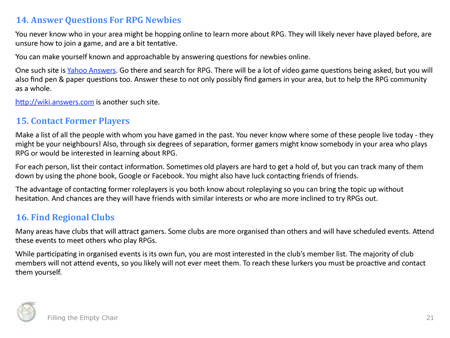Filling the Empty Chair is a PDF resource designed to help gamers find people to play with. Written by Johnn Four, the the editor of Roleplaying Tips, it combines player-finding advice with freely-available information. It’s a 30-page PDF available for download from RoleplayingTips.com for $7.
This is a review of Version 1.03. As the back of the book indicates, this is a “living document” and may be updated as resources change, etc.

Johnn emailed me and asked if I’d like to review Filling the Empty Chair, which he thought it might interest Gnome Stew readers, and I agreed that folks would enjoy hearing about it — it’s hard to be a GM without any players, after all! I received a complimentary copy to review, and I was excited to take a peek at it.
Finding players is a subject that’s near and dear to my heart, and I’ve been a fan of Johnn’s work for over a decade — the Roleplaying Tips newsletter has been online since 1999, practically forever in Internet time.
Gaming is the heart of my social life. If you’re more in the “take it or leave it” camp when it comes to gaming regularly, then the pressure’s off for finding players — you find them or you don’t, and life moves on. But we all know what it’s like to move to new city, graduate, change jobs, or otherwise suddenly find yourself with a desperate itch to game and no group to game with.
If that sounds like you, then read on to find out how Filling the Empty Chair can help you meet some new players.
Overview
Filling the Empty Chair is a 30-page landscape-format PDF that retails for $7. Minus the cover, intro, and a page about how to get free updates to the book, you get 27 pages of resources and advice for finding players. This is divided into three sections: online resources, tips and advice, and writing your gamer profile.
The cover, done in a cartoon style, is simple and eye-catching; I dig it. It’s also the only art in the book, excluding website logos. The layout is plain, with two columns in the resource section and a single column elsewhere. It’s designed for screen reading, and it gets out of the way and lets you read without any distractions.
The text is clean as well, with no obvious typos or grammatical issues. It’s a light, pleasant read, and is well-matched to the topic: simple, practical, and straightforward. There’s a good overview of the book on its product page, but no sample; that’s a downside for me, as a sample can be a real indicator of what you’re going to get out of a product.

For $7, though, I expect better production values across the board — this looks like a Microsoft Word file. As a publisher, I have a bit of a bias in this department, but the way this book looks would annoy me as a consumer, too.
The Resources
The first 11 pages offer up a list of gamer-finding websites and forums, 39 in all. The Yahoo! Groups entry includes 20 individual groups, so there are 58 resources if you count each of those separately.
Johnn has loosely ranked the resources from best to worst, and having used many of these resources myself the order is a pretty accurate reflection of my own experience. (Yours will vary, of course, as there’s a fair amount of luck in any player-finding venture.)
He also provides a short profile for each resource, including the hyperlinked URL, game types (tabletop, PbEM), game systems, dominant regions, format (forum, website), and a short write-up. Here’s the entry for NearbyGamers, one of my personal favorite player-finding resources:
http://nearbygamers.com/
Game types: tabletop, PBeM, forum, virtual
Game systems: various
Dominant regions: global
Format: registry, profileThis excellent site lets you zoom into your region on a map to see who has registered nearby. You can also find local gamers by game system. Be sure to add your profile.
This section of the book consolidates a lot of information into a relatively small space, and saves you the trouble of tracking it all down yourself. You could sit down, spend a couple of hours signing up and posting in as many of these places as possible, and cast a nice wide net for players without a huge time investment.
With Johnn’s list, I don’t have to waste my time checking out the Wizards RPG Gamer Classifieds if I’m running a virtual game, because according to the “Game types” section for that entry, they only deal with tabletop games. Nor do I have to wade through the chaff to find the wheat, because the wheat is right at the top of the list.
On the flipside, you can find all this info yourself online for free, provided you have the time to do so — a little Google searching will turn up the top resources in Johnn’s list. For me, the value is in the consolidation.
I do wish that each entry covered a bit more ground, though. For example, how many people use NearbyGamers? And why is it ranked so highly in Filling the Empty Chair? Knowing that would help me decide if it’s worth my time to create a profile there. The quick overview is nice, but if I’m investing some time to find a player I’d prefer to have more information at hand.
Player-Finding Advice
The next 12 pages are devoted to providing 28 specific pieces of gamer-finding advice, ranging from “Get a Business Card” (#1) to “Check Dating Sites” (#28). This section is a mixed bag, with some excellent advice and some tips that need expansion. It’s also a bit hard to evauluate because there are so many variables involved in in looking for players — my experience may be totally different from yours, and color my opinion of a particular tip accordingly.
For example, #2 is “Advertise in Stores,” something I’ve done on a few occasions over the years with zero luck. Responses have ranged from weird and creepy to just crickets — in my experience, this is one of the worst ways to find players around, and doesn’t rate being second on the list or getting a more in-depth treatment than some of the other entries.
But there’s also a lot of good advice in this section, including some real gems. One of my favorites is #18, “Get a T-shirt,” which recommends custom-printing a “gamers wanted” T-shirt for guerilla recruiting.
I was once stopped on the street by an Amber player who wanted to recruit me solely because I was wearing a T-shirt with an Amber quote on it. Had I not been moving out of the state a few days from then, I would likely have met some great folks just because I wore a geeky shirt. It never occurred to me to do this on purpose, and it’s a great idea.
This section also does a good job of speaking to gamers at a variety of points in their lives. For example, tip #22 is “Start a Club at School,” which won’t apply to someone outside of high school or college, but is a fantastic way to meet and recruit gamers in both of those places.
In general, though, this section could benefit from more information in almost every case. Take an entry like #20, “Create a Gaming Blog”: This entry is a short paragraph and a link to WordPress.com. With the wealth of info Johnn has on hand by way of Roleplaying Tips, which is put to good use for some entries, there’s plenty of room to expand on this meaty topic.
The Perfect Profile
The final four-page section covers writing the perfect profile — dating advice for gamers, essentially. Many player-finding sites require a profile of some sort, and it’s not always easy to know what to write and what not to write; Filling the Empty Chair covers both aspects of this process very well.
This section offers simple, cogent advice on building a good RPG profile and avoiding common pitfalls — things like listing every game you’re willing to play, something that prompts a more or less instant “Thanks, but no thanks” from my group.
It’s a good way to finish off the book, and not a topic I’ve seen covered anywhere else.
Value for the Money
Filling the Empty Chair is the most comprehensive resource of its kind, but on balance it’s not comprehensive enough to justify its price tag. It either needs more content and better layout or a lower price tag that matches its size and production values.
Weighing Filling the Empty Chair against other PDFs in the same price range, it comes up lacking. While $7 isn’t a lot of money, 30 pages (27 of actual content) for $7 with no art and low production values isn’t a good deal.
Like any gaming book, though, things get fuzzy when you consider the value of the content. If this book helps you find an awesome new player, it’s worth a lot more than $7. But considered solely on its own merits, it’s not worth $7.
Should I Buy It?
Whether it’s worth buying will largely depend on your situation: If you’re short on time, new to gaming or new to looking for players, just moved to a new city and don’t know anyone, or have always had back luck meeting players, picking up Filling the Empty Chair will save you some time and potential heartache.
In particular, if you’ve never tried finding a new player before, this book will give you a good idea of how to go about it, where to look, and what not to do — it’s perfect for your situation.
If none of the above applies to you, though, you’re likely to be disappointed by this book’s appearance and by the amount of content that it provides (and that may be true if even the above does apply).
Questions?
If you have questions about Filling the Empty Chair, I’d be happy to answer them — fire away in the comments!

















Thanks for taking time to do the review, Martin! Your feedback is super, and I’ll be using it when making the next update to the product.
Cheers.
I disagree about advertising in stores, Martin. I’ve had great results with store ads. I make it a point now to meet potential new players at an FLGS, usually the one where they found my ad at. Meeting at the game shop tends to cause people to act more naturally and to be themselves. Even shy people tend to open up a bit more when you stroll over the bookshelf and say “Own any of these?”.
My brother used to say that if you made a recipe twice a month for a year, the recipe book you found it in was worth every dime. If the pointers in this PDF bring in one new player who fills a chair for an entire year, wouldn’t that be worth $7?
It all comes down to the quality of the advice.
@JohnnFour – You’re welcome, Johnn! I’m glad my feedback was useful to you.
@Patrick Benson – This is definitely a YMMV review, which I tried to be clear about — store ads have always sucked for me, but they’ll work great for other people. And they’re free, which is never bad.
@TwoShedsJackson – Yep, it’s absolutely worth $7 — or much more — if Filling the Empty Chair helps you recruit a new player. There’s some good stuff in there.
@Martin Ralya – Yes, you were clear about that. I was just offering a different perspective and a tip for others. 🙂